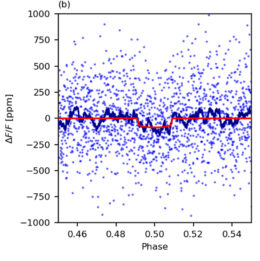Among the wealth of exoplanets we’ve discovered beyond our solar system, some are temperate, some less so. New observations have now revealed what may be a particularly inhospitable environment: a planet literally disintegrating as it orbits its host.
Peering Through the Shroud

Artist’s illustration of another DMPP-discovered planetary system, DMPP-2. [Mark A. Garlick/Haswell/ Barnes/Staab/Open University]
In December 2019, DMPP announced its first discoveries: six planets orbiting around three different target stars. Now, in a new publication led by scientist Mark Jones (The Open University, UK), the team has revisited the first of these systems, DMPP-1, with follow-up photometry from the Transiting Exoplanet Survey Satellite (TESS).
Intriguingly, the radial-velocity-detected planets are not the only signals from this system.
Missing the Expected, but Finding the Unexpected
DMPP-1 is a 2-billion-year-old star located just over 200 light-years away. The radial-velocity observations of this system revealed the gravitational tugs of four planets all orbiting with periods of less than 19 days. The radial-velocity data suggest that this system is probably near edge-on and contains three super-Earths and one Neptune-like planet.

Phase-folded TESS light curve for DMPP-1, identifying a weak transit signal with a period of P = 3.2854 days. [Jones et al. 2020]
The authors did, however, find a new signal: a weak transit detection with a period of just ~3.3 days. This signal doesn’t match any of the known radial-velocity planets.
A Disappearing Planet?
What might this marginal detection be? Its variable transit depths, short period, and apparent small size are all consistent with a catastrophically disintegrating exoplanet — a close-in, small, rocky planet that is so irradiated by its host that its rocky surface is being sublimated. As time goes on, such a planet will eventually disintegrate into nothing.

The depths of the seven detected transits are highly variable, with one even consistent with a depth of zero! This variability is common for disintegrating planets, as the cloud of ablated material is the primary cause of the transits. Click to enlarge. [Jones et al. 2020]
By exploring the transit signals from DMPP-1 with future technology like the James Webb Space Telescope, we will be able to examine the composition of the ablated material, potentially revealing clues as to how hot, rocky inner planets form and evolve.
Citation
“A Possible Transit of a Disintegrating Exoplanet in the Nearby Multiplanet System DMPP-1,” Mark H. Jones et al 2020 ApJL 895 L17. doi:10.3847/2041-8213/ab8f2b

5 Comments
Pingback: From AAS NOVA: ” Are We Watching a Planet Disintegrate?” | sciencesprings
Pingback: NASAの探査衛星TESS、蒸発しつつある系外惑星を検出か | sorae 宇宙へのポータルサイト
Pingback: Are We Watching a Planet Disintegrate? » What's Goon
Pingback: Are We Watching a Planet Disintegrate? - Sky & Telescope - Worldika - New Platform For Explore World
Pingback: Are We Watching a Planet Disintegrate? – Storm-Tech Nomad